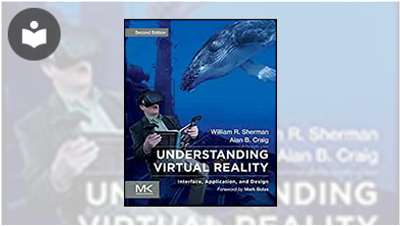Understanding Virtual Reality: Interface, Application, and Design, Second Edition
- 17h 46m
- Alan B. Craig, William R. Sherman
- Elsevier Science and Technology Books, Inc.
- 2019
Understanding Virtual Reality: Interface, Application, and Design, Second Edition arrives at a time when the technologies behind virtual reality have advanced dramatically. The book helps users take advantage of the ways they can identify and prepare for the applications of VR in their field. By approaching VR as a communications medium, the authors have created a resource that will remain relevant even as underlying technologies evolve. Included are a history of VR, systems currently in use, the application of VR, and the many issues that arise in application design and implementation, including hardware requirements, system integration, interaction techniques and usability.
About the Authors
William R. Sherman is a member of the Indiana University Advanced Visualization Lab, where he leads efforts in Scientific Visualization and Virtual Reality. He also teaches undergraduate and graduate courses on VR and Visualization, which he has done for two decades, including at the University of Nevada, Reno (UVR), and at the University of Illinois at Urbana-Champaign (UIUC).
Previously he founded the Center for Advanced Visualization, Computation and Modeling (CAVCaM) at the Desert Research Institute (DRI), where he led the VR and Visualization efforts, including overseeing the installation of a FLEX CAVE-style VR system as well as a 6-sided CAVE system. Prior to DRI, he led the virtual reality effort at the National Center for Supercomputing Applications (NCSA) at UIUC, working with the Electronic Visualization Lab to install and operate the second CAVE VR system.
He has authored several book chapters and papers on the topics of scientific visualization and virtual reality, and has organized and led "bootcamps" on immersive visualization in collaboration with the Idaho National Lab and Kitware Inc. Sherman is the architect of the FreeVR VR integration library. He has attended every single IEEE Virtual Reality conference since 1995, and was chair of the 2008 conference.
Dr. Alan B. Craig is an independent consultant in Virtual Reality, Augmented Reality, Visualization, and High Performance Computing. Prior to this role, he contributed much to these fields during his thirty-year career at the University of Illinois at Urbana-Champaign (UIUC) as a Research Scientist at the National Center for Supercomputing Applications (NCSA) and as Senior Associate Director for Human-Computer Interaction at the Institute for Computing in Humanities, Arts, and Social Science (I-CHASS). Among his other consulting roles, he is currently engaged with the Extreme Science and Engineering Discovery Environment (XSEDE).
Dr. Craig has been called upon to speak as an expert in VR and AR at countless worldwide events and continues to speak at various venues. He has taught classes related to VR and AR online as well as onsite at universities, companies, and high school campuses. Dr. Craig has worked with government and industry entities regarding VR and AR applications. He has been interviewed by numerous publications, television, and news outlets.
In addition to Understanding Virtual Reality (with William R. Sherman) he also authored Developing Virtual Reality Applications (with William R. Sherman and Jeffrey D. Will) and Understanding Augmented Reality. Additionally, he has written multiple book chapters and articles. He has developed many virtual reality and augmented reality applications in content areas ranging from archaeology to zoology. He also teaches and advises on related topics. His primary focus has been on the use of virtual reality and augmented reality in educational applications and his work centers on the continuum between the physical and the digital. He holds three patents.
In this Book
-
Foreword
-
Introduction to Virtual Reality
-
VR—The Medium
-
The Human in the Loop
-
Input—Interfacing the Participant(s) with the Virtual World
-
Output—Interfacing the Virtual World with the Participant(s)
-
Presenting the Virtual World
-
Interacting with the Virtual World
-
Bringing the Virtual World to Life
-
Experience Conception and Design—Applying VR to a Problem
-
Virtual Reality—Past, Present, Future
-
References



